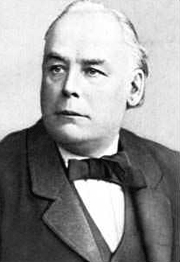On this date in 1833, England’s best-known proponent of atheism, reformer Charles Bradlaugh, was born in London. He left school at age 11 to earn his living. When he announced his freethought views, he was forced to leave his family home and found support among other freethinkers, including the children of oft-jailed publisher Richard Carlile. Bradlaugh worked as a coal merchant. After joining the army, he worked as a solicitor’s clerk, learned the law and became an attorney.
He wrote and lectured about freethought under the pseudonym “Iconoclast.” Bradlaugh briefly became editor of the freethinking bi-weekly periodical The Investigator in 1858. By the time he became co-editor of the National Reformer in 1860, he was a famed social reformer and orator, known in England and abroad. In 1866 he founded the National Secular Society. Bradlaugh had two daughters and one son with his wife, whose serious drinking problem broke up the family in 1870.
Bradlaugh’s challenge in 1868-69 of the Security Laws, inhibiting distribution of controversial periodicals, brought their repeal. He also championed land reform. In 1876, he and colleague Annie Besant were prosecuted for “obscenity” for republishing a birth control booklet, The Fruits of Philosophy, by American doctor Charles Knowlton. After a long trial, the pair were convicted and faced jail and fines but were freed on a technicality. Bradlaugh was urged to run for Parliament in 1868, placing fifth. He ran several times before winning in 1880 but was refused seating because he would not take the religious oath.
Bradlaugh was reelected four times before finally prevailing in his fight to be seated in 1886, but the legal fight had drained him financially. Bradlaugh persuaded Parliament to pass a bill permitting the right to affirm in 1888. Bradlaugh lectured three times in the U.S. in the 1870s and was warmly received in India during his 1889 visit. His only surviving child, Hypatia Bradlaugh Bonner, took up the freethought/reform cudgels, also defending her father’s reputation from numerous “death-bed conversion” fables. D. 1891.


